One of the most common issues that beginning jazz guitarists run into is how to read from a fake book and properly interpret jazz chord symbols. In this lesson, you will learn how lead sheet changes are written. You will add chord colors and tensions to basic chord changes, and learn a sample comping study to help you take these ideas into your playing.
When first reading chord changes for popular jazz standards in lead sheet form, we are confronted with what looks like very plain chords, such as Dm7, G7, and Cmaj7. But, when you hear great players comp over these tunes they aren’t sticking to these written chords. Instead, they use m9, 7b9, 13, maj6, and other chord colors and tensions to decorate these changes.
These kinds of chords sound cool and are something many of us desire to add to our own playing. But, how do you take the basic jazz chords from the Real Book and make them sound as colorful as the great players’ chord comping?
By the end of this lesson, you will be able to play from a fake book, understand the changes, and comp over them in a musical and practical fashion.
Lead Sheet Chord Changes
The first aspect of learning how to read a lead sheet for guitar is to understand how chord changes are written in fake books such as the Real Book. The chords on jazz charts are often written in a simple style such as Dm7, G7, Cmaj7, Em7b5, A7alt, etc., rather than very specific chords such as Dm9, G13, C6, Em11b5, A7b9, etc.
It is up to us to play those basic changes in a more colorful way by adding chord extensions, tension notes and chord substitutions.
To get you started, here are the first 8 bars of Autumn Leaves:
- In the first 8 bars of the audio, you’ll hear the guitar player play the exact chords as written in the Real Book.
- in the second 8 bars the chords are interpreted in a more real-world fashion with colors and tensions added.
This will give you an idea of how the two approaches sound before moving on to studying the various chord alterations in the rest of this lesson.
Listen & Play Along

Adding Chord Colors to Lead Sheet Changes
One of the biggest misconceptions when first learning how to read jazz chords is that the chords you see are the chords you play, which isn’t necessarily the case. When playing through lead sheet chords, you need to develop the ability to see a basic chord and play it in a creative way by adding colors to the chord.
The first thing to know when adding chord colors to basic changes is the options you have for each of these chords.
To help you understand your options, here are the most common chord colors:
- Major 7 = maj7, maj6, maj9, maj6/9
- Dominant 7 = 7, 9, 13, 7#11
- Minor 7 = m7, m6, m9, m6/9, m11, mMaj7 (if in place of a tonic m7 chord)
- Half Diminished = m7b5, m11b5
- Altered Chords (7alt) = 7b9, 7#9, 7b5, 7#5, 7b9b5, 7b9#5, 7#9b5, 7#9#5
To give you an example of how to apply chord colors to a tune, here is an example over the first 8 bars of Autumn Leaves:
Listen & Play Along
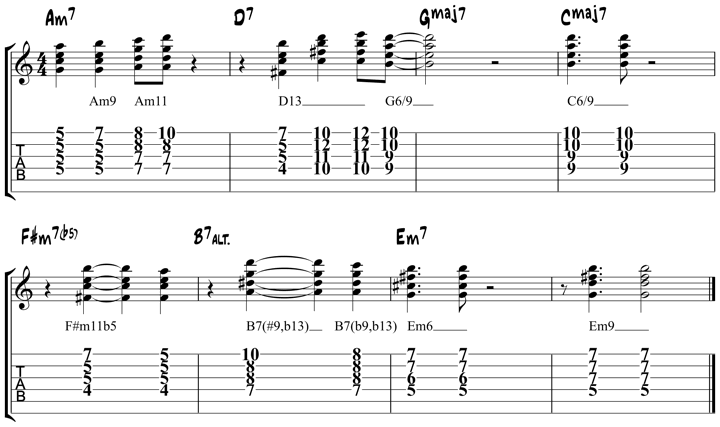
To get this technique under your fingers and build confidence with adding chord colors to lead sheet changes, try opening the Real Book, pick a random tune and then a specific chord color to add to all of the chords in that tune.
For example, you could add 9ths to every chord, such as reading m7, 7 and maj7 chords and playing them as m9, 9, and maj9 chords.
Adding Chord Tensions to Lead Sheet Chords
Apart from adding extensions to lead sheet chord changes, you can also add tensions to these chords. You have to be more careful with tensions and make sure they resolve properly in your comping.
Some examples of adding tensions to a lead sheet chords:
- Playing G7b9 when you see G7.
- Playing Cmaj6/9#11 when you see Cmaj7.
Common tensions over Dominant chords would be the b9, #9, b5, and #5, or any combination of those intervals.
Over maj7 chords, the #11 and #5 are both common tension tones that you can add to your comping.
Here is an example of how you can add tension tones to the A section of Take the A Train, a common jazz standard and a great vehicle for testing out new approaches to comping.
Listen & Play Along
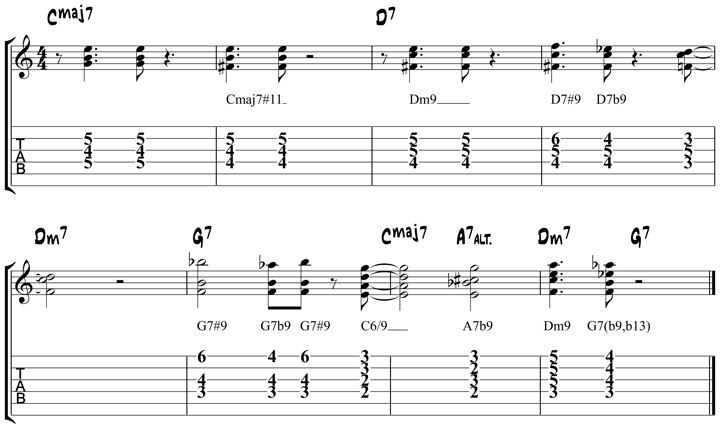
The Melody is King
While you do have the freedom to add colors and tensions to any chord you are playing, the one thing that will dictate specific chords in your playing is the melody line. Behind a soloist, adding a 9th, 13th, or 7b9#11 chord can be inspiring for the soloist and other band members to play with, but behind a melody line those changes can cause unwanted clashes.
When working on reading chords during the melody section of a tune, the first place to look for specific chord colors and tensions is in the melody.
For example:
- If you see a G7 chord and you decide to add a 13th, that could cause a clash if a b7 is played in the melody. If you put a 13 on the top of your chord (the note E) and the singer sings the b7 (F), that half-step interval between you and them will cause an unwanted dissonance that might not sound good to the audience and make it hard for the melodist to tune at the same time.
- If you see a C major chord and you play a 7 on top of your chord (B), while the singer sings a 1 (C). The half-step interval between B and C will cause dissonance.
Here is an example of how you would look at a melody line and let the notes of the melody decide which chord colors you play.
Listen & Play Along
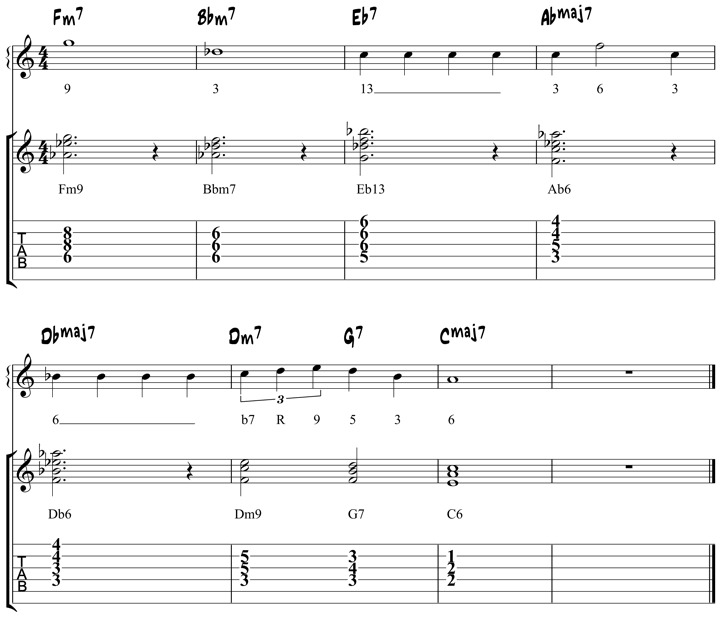
To take this approach further, take any lead sheet out of the Real Book, look at the melody and then work out chord colors based on the notes of the melody. Doing this slowly with a lead sheet at first will then allow you to do this in real time during a jam or gig.
Adding Chord Subs to Lead Sheet Changes
Along with chord colors and tensions, you can also add chord substitutions to any chord progression you are reading through.
For example, if you see a ii-V-I chord progression in a lead sheet, you could use a tritone substitution (ii-bII-I) over those changes in a soloing situation, and in a melody situation if it doesn’t clash with the melody.
You can also use other chord substitutions over common changes, such as playing iii-VI-ii-V over a I-vi-ii-V turnaround, or Countdown subs over ii-V-I chord changes in the style of John Coltrane.
Here is a sample of a tritone sub being applied to the first 8 bars of Autumn Leaves, over the V7 chord in bar 3 and bar 6 of the changes.
Listen & Play Along
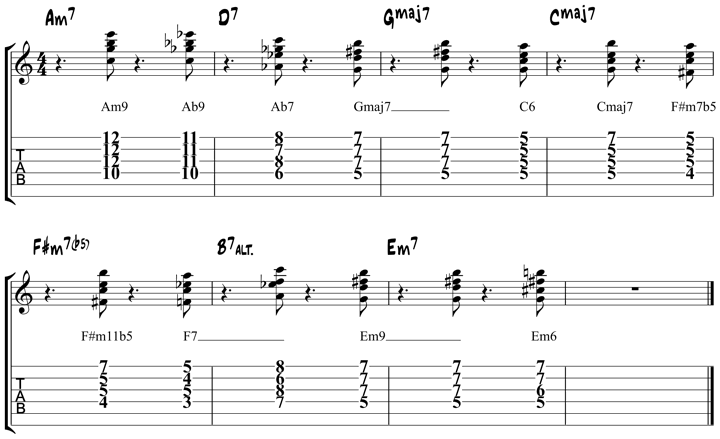
Sample Lead Sheet Comping Study
To finish your introduction to reading jazz guitar chords, here is a sample comping study over the standard Summertime. In this study, you will see how the chord changes are written in a lead sheet style, but the chords have been colored.
Each chord color or tension is labeled so you can see how the lead sheet chords were interpreted in the real-life comping example.
Listen & Play Along
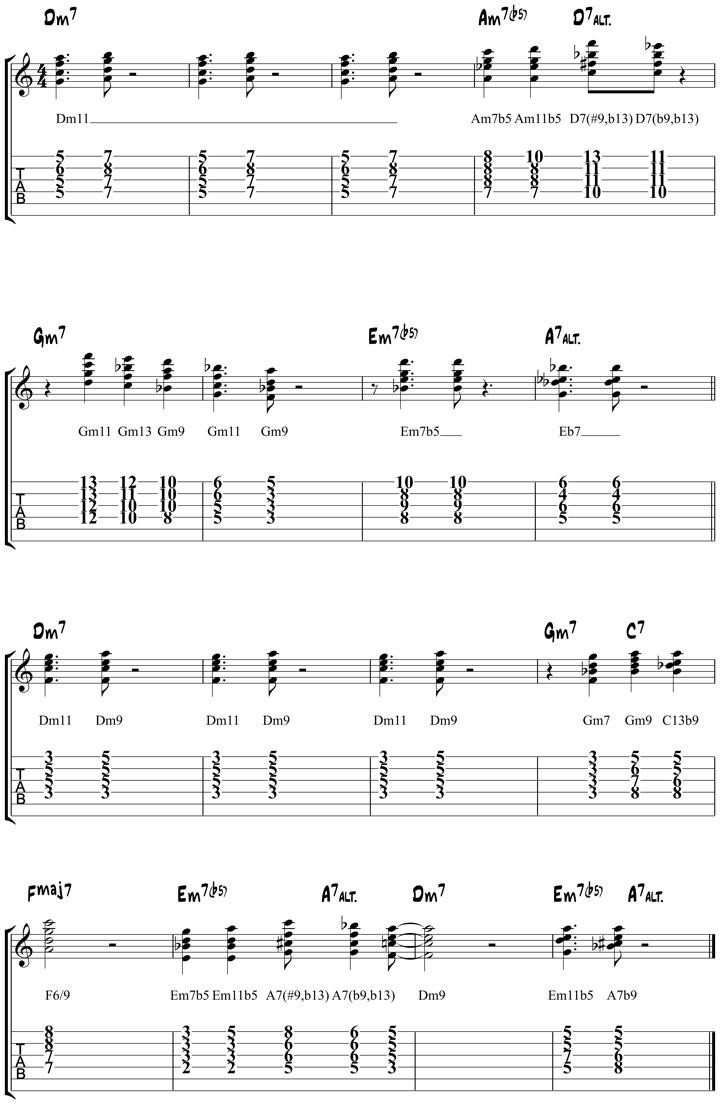
After you have learned this chord study, try playing over Autumn Leaves on your own, adding chord colors and tensions in a similar style along the way in order to expand your ability to interpret chord changes in a practical, musical fashion.
If you need help with this lesson, leave a comment below…


This may be a foolish question. I do understand tab but the chord diagrams confuse me. For example, in the Cmaj7 chord where I see 5,3,7, do the numbers represent fret position? Is the orientation of the chord diagram vertical or horizontal? If 5, 3, 7 are fret positions why are next to each other? Could these be notes on the scale rather than frets? I feel like an idiot because when these diagrams do not look like other tab diagrams. Thank you
I’m new to theory and trying to wrap my head around why in the “Adding Chord Colors” example in the second through third bar you call the same chord (BFGA) a G6/9 and then C6/9? Sorry in advance if this is a dumb question.
Hi Daniel, good question! The notes of G6/9 are G B D E A, and those of C6/9 are C E G A D. E A D and G are common notes between the two chords, that’s why the same voicing can be used for both chords. It’s the bass note or place in the harmony that determines the name of the chord in this case.
We’ve tended to keep all the V7 chords strictly as base V7 chord tones so that the melodic improv is free to use, and we can hit all the altered tones without fear of a clash.
Thanks teacher!
Another great lesson – very inspiring!
Thanks Dieter!
Thanks for all the lessons, Dirk! Much appreciated! Keep up the good work.
Muito massa essa dica gente,hoje aprendi mais sobre jazz
Thank you
Blessed with your generosity! Thanks, great lesson. GDCormier
Great comping lesson! I think one could spend a lifetime exploring different ‘chord voicing phrases’. The point of using the melody to guide one’s choice of chord extensions, while seeming obvious, was a very important tip. Thanks for the useful examples!
Thanks for this ear-opening lesson. It not only has great examples, it allows patient students to deconstruct what you’re demonstrating, and learn or refresh their understanding of how chords sound and work together. The more you work it out and think about it, the more you learn. Very useful!
SUPER !!!!!
Thanks Janusz!
Great information. Thank you. John
Glad you like the lesson!